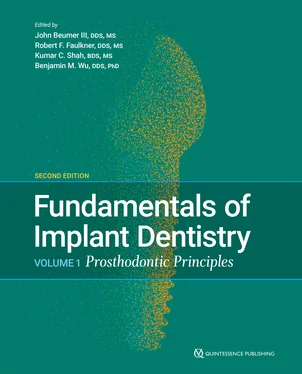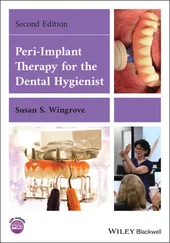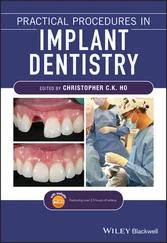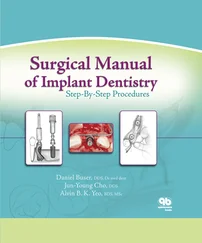31.Wilson TG. The positive relationship between excess cement and peri-implant disease: A prospective clinical study. J Periodontol 2009;80:1388–1392.
32.Spear F. Using margin placement to achieve the best anterior restorative esthetics. J Am Dent Assoc 2009;140:920–926.
33.Abrahamsson I, Zitzmann NU, Berglundh T, Linder E, Wennerberg A, Lindhe J. The mucosal attachment to titanium implants with different surface characteristics: An experimental study in dogs. J Clin Periodontol 2002;29:448–455.
34.Abrahamsson I, Berglundh T, Linde J. The mucosal barrier following abutment dis/reconnection. An experimental study in dogs. J Clin Periodontol 1997;24:568–572.
35.Rompen E. The impact of the type and configuration of abutments and their (repeated) removal on the attachment level and marginal bone loss. Eur J Oral Implantol 2012;(5 suppl):S83–S90.
36.Vigolo P, Gracis S, Carboncini F, et al. Internal- vs external- connection single implants: A retrospective study in an Italian population treated by certified prosthodontists. Int J Oral Maxillofac Implants 2016;31:1385–1396.
37.Gilbert M, Vervaeke S, Jacquet W, Vermeersch K, Östman PO, De Bruyn H. A randomized clinical trial to assess to assess crestal bone remodeling of four different implant designs. Clin Implant Dent Relat Res 2018;20:455–462.
38.Lazzara RJ, Porter SS. Platform switching: A new concept in implant dentistry for controlling postrestorative crestal bone levels. Int J Periodontics Restorative Dent 2006;26:9–17.
39.Rodríguez X, Vela X, Calvo-Guirado JL, Nart J, Stappert CF. Effect of platform switching on collagen fiber orientation and bone resorption around dental implants: A preliminary histologic animal study. Int J Oral Maxillofac Implants 2012;27:1116–1122.
40.Paul S, Padmanabhan TV, Swarup S. Comparison of strain generated in bone by “platform-switched” and “non-platform-switched” implants with straight and angulated abutments under vertical and angulated load: A finite element analysis study. Indian J Dent Res 2013;24:8–13.
41.Annibali S, Bignozzi I, Cristalli MP, Graziani F, La Monaca G, Polimeni A. Peri-implant marginal bone level: A systematic review and meta-analysis of studies comparing platform switching versus conventionally restored implants. Clin Periodontol 2012;39:1097–1113.
42.Enkling N, Jöhren P, Katsoulis J, et al. Influence of platform switching on bone-level alterations: A three-year randomized clinical trial. J Dent Res 2013;92(12 suppl):139S–145S.
43.Bassetti M, Kaufman R, Salvi GE, et al. Soft tissue grafting to improve the attached mucosa at dental implants: A review of the literature and proposal of a decision tree. Quintessence Int 2015;46;499–510.
44.Arisan V, Karabuda CZ, Mumcu E, et al. Implant positioning errors in freehand and computer-aided placement methods: A single-blind clinical comparative study. Int J Oral Maxillofac Implants 2013;28:190–204.
45.Celletti R, Pameijer CH, Bracchetti G, et al. Histologic evaluation of osseointegrated implants restored in nonaxial functional occlusion with pre-angled abutments. Int J Periodontics Restorative Dent 1995;15:562–573.
46.Krekmanov L, Kahn M, Rangert B, et al. Tilting of posterior mandibular and maxillary implants for improved prosthesis support. Int J Oral Maxillofac Implants 2000;15:405–414.
47.Bevilacqua M, Tealdo T, Menini M, et al. The influence of cantilever length and implant angulation on stress distribution for maxillary implant-supported fixed prostheses. J Prosthet Dent 2011;105:5–13.
48.Bellini CM, Romeo D, Galbusera F, et al. A finite element analysis of tilted versus nontilted implant configurations in the edentulous maxilla. Int J Prosthodont 2009;22:155–157.
CHAPTER 2
Osseointegration, Its Maintenance, and Recent Advances in Implant Surface Bioreactivity
Ichiro Nishimura | Takahiro Ogawa | Basil Al-Amleh | Momen Atieh Andrew Tawse-Smith | Benjamin M. Wu
After the concept of osseointegration was introduced, a high rate of treatment success was achieved in quality bone sites with sufficient volume. The original titanium implants were available in machined surfaces or titanium plasma spray surfaces. Eventually, titanium implants with microrough surface topography were introduced that accelerated the events 1associated with osseointegration and led to stiffer bone anchoring the implants. 2This chapter discusses the biologic sequence of host tissue reactions during the process of implant osseointegration and the pathologic factors that potentially can disturb the maintenance of dental implant systems after they have been placed into function. In addition, recent advances aimed at improving the bioreactivity of implant surfaces are discussed.
Protein Adsorption (Seconds to Minutes)
Upon contact with blood, the implant surface is immediately covered by the noncellular components within the blood. 3These primarily include ions, proteins, salts, lipids, glucose, and numerous metabolic byproducts at various stages of their life cycles. All of these components, especially proteins, interact within the first second and immediately act to modify the physical-chemical-biologic properties of the dental implant surface. Among proteins in blood, albumin is the most abundant, followed by fibrinogen and gamma globulin. The initial nanometer-thick layer of proteins present chemical moieties from amino acids with charged, polar, and nonpolar functional groups. These functional groups interact with the implant surface via weak secondary bonds (hydrogen bonding, van der Waals, and electrostatic interactions), and those that bind strongly will stay longer on the material’s surface. 4The early-binding proteins that bind weakly will desorb away from the surface, displaced by stronger binders. The binding force depends greatly on the implant surface chemistry, the protein composition, and the local environment, including pH, ionic concentration, and cellular activities. Over time, the strongly bound proteins can undergo unfolding, which denatures the protein and exposes additional amino acid functional groups that further stabilize the protein-implant interaction. This time- and surface- dependent microevolution of protein composition based on kinetics and stability of protein adsorption is known as the Vroman effect and is relevant for all blood-contacting biomaterials. 5
Once bound to the implant surface, the adsorbed proteins interact with the local biologic molecules via receptor-ligand interactions. These include dissolved proteins (more albumin, fibrinogen, etc) and extracellular matrix proteins such as collagen, von Willebrand factors, fibronectin, coagulation factors, complement proteins, and cell fragments such as platelets that indirectly and directly promote the initial matrix-to-cell adhesion.
Regardless of the surface treatments that have been attempted by dental implant manufacturers, protein adsorption occurs on all materials regardless of hydrophilicity levels. Regardless of surface topology and surface chemistry, some of the early-binding proteins contain binding sites that either directly or indirectly for platelet adhesion receptors and trigger the next stage: hemostasis.
Hemostasis: Platelet Plug and Fibrinogenesis (Minutes)
Cells and biomolecules in blood
The protein-modified surface dictates the kinetics and thermodynamics that platelet-surface adhesion will occur. In turn, the platelet-modified surface will influence platelet-platelet adhesion, platelet activation, fibrinogenesis, and formation of the provisional fibrin matrix. Platelets carry surface receptors suitable for attachment to exposed or damaged collagen fibers while secreting internally stored bioactive factors. In blood, platelets initially rely on their high shear stress receptors to gain initial adhesion, followed by the engagement of low shear stress receptors. 6Because blood flow is slow in dental osteotomy sites, both low and high shear stress receptors on platelet surfaces can contribute to binding. The platelet- derived factors include a series of enzymes that are essential for the cascade of the coagulation process resulting in fibrin and clot formation. These activated platelets also regulate the subsequent inflammatory response and wound healing processes. The fibrin clot not only works as a temporary “plug” to prevent further bleeding until the fibrin is formed via the intrinsic and extrinsic clotting pathways—the resultant fibrin plug, with trapped platelets inside, serves as a bioactive scaffold for epithelial and mesenchymal cell migration to commence wound repair.
Читать дальше












